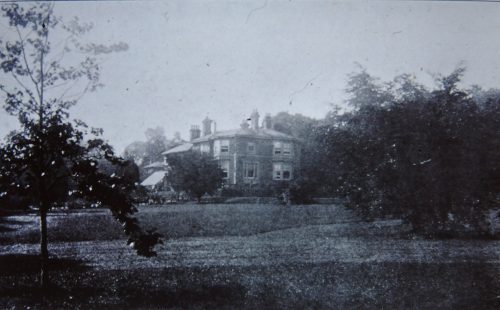Ryde Architecture
GWYDYR HOUSE
On 30 October 1844 the Hon. Lindsey Burrell entered into an agreement with the ground landlord Dr. James Lind to rent the fields which were in the occupation of Jolliffe & Taplin (Field Nos. 120, 121 Newchurch Tithe map.) The rent was £35 per annum, £150 on 3 lives renewable forever. There was a covenant that a house to the value of £1,200 had to be built within three years. Any additional houses had to be a value of over £1,000 with an additional rent of £10 per annum for every house. The carriage entrance had to be in Spencer Road at the north east corner of the land.
The Hon. Peter Merrick Lindsey Burrell was the 2nd son of the first Lord Gwydyr. Lindsey was born 20 June 1786; married 13 July 1807, Frances, daughter of James Daniell. She died 25 August 1846 and he died 21 January 1848, leaving issue. His sister Elizabeth Julia Gertrude married John 2nd Earl of Clare and after the split up of the marriage she lived in Brigstocke Terrace, St. Thomas’ Street, Ryde.
The Hon. Lindsey Burrell’s main home was Stoke Park, Ipswich and Gwydyr House would have been his marine residence. He was a trustee and founder member of the Royal Victoria Yacht Club. When finance was short he helped with the building of the Holy Trinity Church, Dover St. Ryde.
Prior to having had Gwydyr House built he rented houses in Ryde, for example in 1839, Buckingham Villa, which was owned by The Duke of Buckingham.
After the death of the Hon. Lindsey Burrell, the house was rented out to several persons, but in 1853 it was taken by Mr. John Mears and he stayed until 1862. The Census of 1861 described him as a widower who had a son and two daughters living with him, plus 5 living in servants and a coachman occupying the lodge. After Mr. Mears left in 1862 the house was occupied for about a year by members of the Burrell family.
In August 1862 Gwydyr House was advertised: To be Sold or Let, furnished or unfurnished, a modern villa residence situate near Spencer-road, Ryde, standing in a lawn of three acres or more, with ornamental Shrubbery and Flower Gardens, approached by a carriage drive from Spencer-road, with an excellent Lodge at the entrance, containing four rooms, greenhouse &c., well adapted for a separate residence. There is also a carriage entrance from the Newport-road.
The House contains double drawing-room, dining and morning-rooms, five principal bed-rooms and dressing-rooms, four servants’ bed-rooms, housekeeper’s-room, servants’-hall, and very replete offices.
The Stabling consists of coach-house, three-stall stable, and harness-room, two good sleeping-rooms over, with lofts, &c. There are two green-houses, a large, productive walled kitchen-garden, gardener’s cottage of four rooms, with yard, &c. Application to be made to Mr. George Riddett, Estate Agent and Auctioneer, Ryde.
In 1863 the Vicar of Newchurch and his wife, Rev. Harding and Mrs. Girdlestone, took the house and stayed until 1867.
In 1868 the house was purchased by Sir Alexander Collingwood Dickson, 5th Baronet. He called in James Langdon, builder, to make alterations and additions to the house and spent over £600.The additions would be on the eastern side of the house.
Sir Alexander was a captain in the Royal Navy. He entered the Royal Naval College at the age of 12 and went to sea two years later. Served at the Mediterranean and at the Cape of Good Hope. He obtained the rank of Commander in 1842 and was placed on half pay. His brother died in 1868 and he succeeded to the title. Lady Dickson, his wife, died in 1882 and he died two years later. There were no children by the marriage. The house then appeared to have been empty for three to four years.
The next known occupiers were Mr. and Mrs. C. Forbes who were there in 1887 and 1888.
The next residents arrived in 1890 – Col. Richard Fetherstonhaugh, who was a serving officer and had fought in the Zulu War of 1879 and the Nile Expedition of 1884-85. Later he went to the South African War 1899-1902 and became a Major General in 1902 and retired on pension in 1904. His wife Florence, who died in 1920, was a member of the Collingwood Dickson family, who had occupied the house earlier. (2 sons were killed in the First World War.) After Richard’s death in 1932, aged 83, the house was divided.
In 1935 Mr. Leslie Albert Jones and Mr. Fred Hawkyard were in residence.
1937 showed the occupants as being Mr. F. Hawkyard, Mr. Wm. Maitland Hutt and Mr. George Cross.
Sources: IW Observer, Newchurch Tithe Map, Census returns, RSHG Archive
Image: Roy Brinton Collection
Article: Ann Barrett

